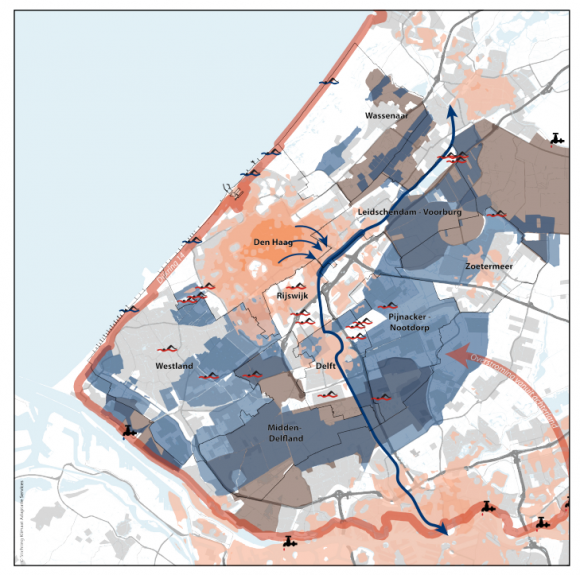Regional Climate Adaptation Strategy Haaglanden: A Joint Strategy
The Haaglanden region intends to rank among the climate-proof international top regions by 2050. In order to achieve this ambition, it is important to factor in future climate change, and to make the most of opportunities that are currently available. The Haaglanden region will also be faced with the consequences of climate change, such as increasing heat and extreme downpours, a rising sea level, and increased chances of prolonged periods of drought. Extreme weather conditions are already causing problems and damage in the area, for example, the extremely dry spring of 2011, and pluvial flooding in the Westland area in 1998, 2000, and on 13 October 2013. Similar events will occur increasingly more often and to an increasingly severe extent. This realisation has prompted the authorities in the region to embark on a Regional Adaptation Strategy (RAS), based on studies and projects that have been conducted since 2002.
In September 2014, the document “Met oog op de toekomst – Regionale klimaat Adaptatie Strategie Haaglanden” [With a view to the future – Haaglanden Regional Climate Adaptation Strategy] was endorsed and submitted to the executive authorities for implementation (see download).
Results
Analysis – Taking the lead in climate adaptation research
The current and future threats and opportunities facing the region have been mapped out on the basis of the most recent data, using the expertise and experience gained in the Waterkader Haaglanden, Leven met Water, and Kennis voor Klimaat programmes. Key instruments in this respect are the interactive climate adaptation atlas and the 3Di decision tool.

The Climate Vulnerabilities Map above outlines the main impact for the Haaglanden region.
Ambition – Opportunities and Taskings for City, Glass, and Grass
The RAS sets out the taskings, opportunities, and required measures for the three types of areas that typify the Haaglanden region (Glass, City, and Grass). They tie in with the core values of the region:
GLASS – A vital, innovative glass sector. The taskings in the densely built-up glasshouse horticulture area are, on the one hand, creating sufficient room for peak water storage, in order to prevent pluvial flooding, and on the other, securing a sustainable freshwater supply. “Supply management” will need to ensure a smart inter-connection, for example, through the dynamic use of irrigation water basins and underground irrigation water storage.
CITY – Habitable cities. The urban area will increasingly be faced with heat issues. In addition, pluvial flooding will increase due to the further densification of the inner city and increasing extreme precipitation. Taking advantage of spatial developments as well as management and maintenance will create both room for peak water storage and a healthy, attractive living environment.
GRASS – Accessible green areas and coastal zone. The Haaglanden peat meadow area is faced with accelerated surface level subsidence. It is important for the climate scenarios and associated effects to be taken into consideration in the administrative choices made with respect to level management. Opportunities are found among farmers who have been adapting to deteriorating circumstances in production for years. They provide increasingly more green-blue services, recreational functionalities, and care functionalities. Opportunities for recreation and tourism arise as more people from the cities take to the green areas and the coast to cool off.

Action – Joining forces, with a view to the future
The solution strategies that have been developed do not require any immediate large investment. They focus on looking for connections between types of areas, linking up with existing taskings, and multifunctional use of space. Taking timely action and capitalising on opportunities will prevent high financial and societal costs in the long run.
The RAS collects the expertise amassed, the resources developed, and the experience gained. It builds on the plans and initiatives that have already been implemented. In the years ahead, the parties involved will continue on this footing, through linkage in implementation and management, but also through their own policy documents, fitting within the spatial economic strategy of the soon to be formed Metropolitan Region Rotterdam The Hague (MRDH). The authorities will continue to exchange know-how and look for collaboration within the official and administrative Water and Climate platform.

Contact person
Arno Lammers
Municipality of the Hague
+31(0)6-42347707
arno.lammers@denhaag.nl
